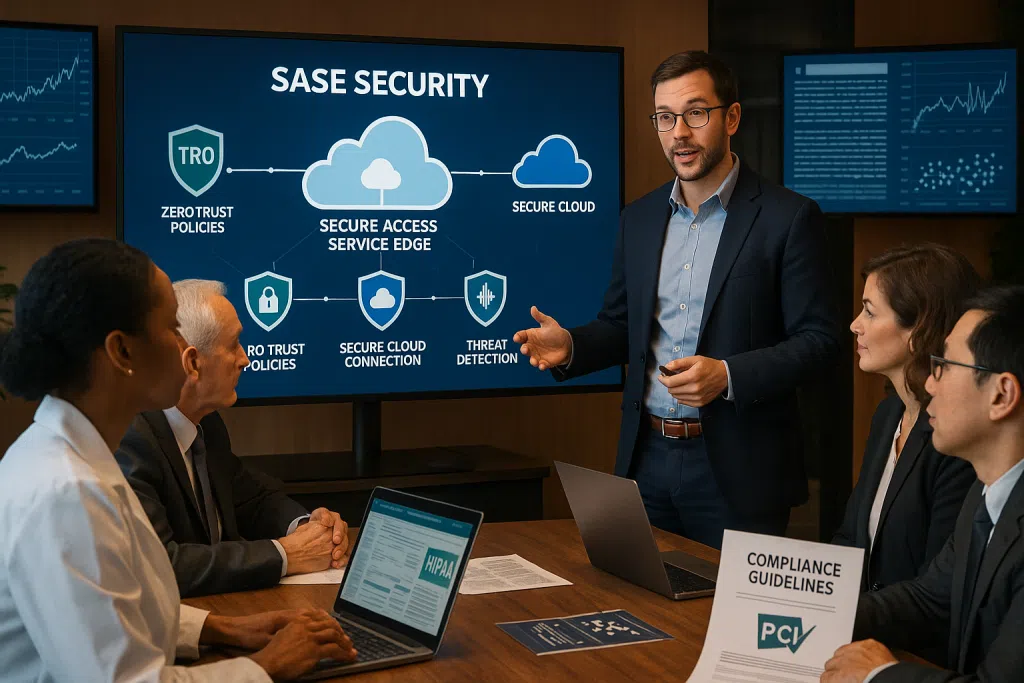Demystifying SASE Security: Understanding the Secure Access Service Edge Approach for Modern SMBs
In recent years, small and mid-sized businesses have faced mounting cybersecurity pressures, from increasingly sophisticated cyber threats to swelling regulatory demands. The rapid shift to cloud services, remote work, and a distributed workforce has stretched traditional perimeter-based security models to their limit. Enter SASE security, a model that’s rapidly transforming how organizations of every size, especially those navigating compliance in healthcare, finance, legal, and pharmaceutical sectors, defend their networks and data.
SASE security, which stands for Secure Access Service Edge, is more than just another security buzzword. It’s a converged framework that unifies wide-area networking (WAN) and multiple security services, including zero trust network access (ZTNA), secure web gateways (SWG), firewall-as-a-service (FWaaS), cloud access security broker (CASB), and more, into one integrated cloud-native solution. At its core, SASE security delivers secure connectivity regardless of where users or devices are located, ensuring consistent enforcement of cybersecurity and compliance controls.
For business leaders tasked with safeguarding sensitive data, meeting compliance mandates like HIPAA, PCI-DSS, or FINRA, and enabling productivity for a mobile workforce, understanding SASE security’s core principles is essential. Here’s a closer look at what SASE architecture entails, why it matters for regulated SMBs, and how your organization can start the journey with an actionable discovery plan.
Book an initial Discovery meeting to explore your SASE security roadmap and compliance risks with a Blueclone Networks specialist.
Essential Building Blocks: SASE Architecture and Its Core Security Components
To grasp the value of a secure access service edge, it’s important to break down its core building blocks. SASE architecture brings together various network security tools and delivers them as a single, cloud-based service. The convergence of network and security systems allows organizations to replace complex, fragmented solutions with an integrated platform that scales as needs change.
Zero Trust Network Access (ZTNA):
- Traditional security models often trusted users and devices inside the corporate perimeter. ZTNA flips that assumption, verifying every user and device before granting access. Verification is continuous, sensitive to context (like user role, device health, or location), and always enforces least-privilege policy. This principle is particularly vital for businesses handling regulated data, as it helps reduce the risk of internal threats and credential misuse.
Firewall as a Service (FWaaS):
- The perimeter firewall isn’t dead, it’s evolved. FWaaS delivers advanced firewall capabilities via the cloud. It protects users and applications wherever they are, without requiring hardware at every site. SMBs, which rarely have hefty IT budgets for physical infrastructure, benefit from centralizing threat management and minimizing gaps.
Secure Web Gateway (SWG):
- A high-performing SWG guards against unsafe or non-compliant web traffic, filtering malicious content and enforcing web access policies. For sectors like healthcare or legal, where handling client data online is routine, SWGs play a crucial role in stopping malware, filtering inappropriate content, and preventing data leakage.
Cloud Access Security Broker (CASB):
- Cloud adoption often outpaces an organization’s ability to control it. CASBs provide unified visibility and policy control over SaaS, IaaS, and PaaS usage. They monitor cloud activity, identify risky behavior, flag shadow IT, and protect sensitive data across third-party apps, a true necessity for regulated SMBs.
Secure SD-WAN:
- A robust network underpins secure digital operations. SASE network security uses software-defined WAN (SD-WAN) coupled with security controls, optimizing traffic flow while enforcing protection from edge to core. This ensures fast, reliable, and secure connections whether employees are on-site, remote, or in branch offices.
Taken together, these individual technologies are orchestrated within the SASE security framework, allowing organizations to simplify management, strengthen defenses, maintain compliance, and provide a consistent user experience.
Navigating Compliance and Risk: Why SASE Security Matters for Regulated SMBs
Cybersecurity compliance is an unavoidable reality for industries handling regulated data. Healthcare providers shoulder the burden of HIPAA and HITECH, law firms must protect attorney-client confidentiality, and financial organizations face FINRA, PCI-DSS, and GLBA requirements. The consequences of noncompliance, ranging from fines to loss of reputation, can threaten the viability of any small or mid-sized business.
SASE security stands out for its ability to align security controls with evolving compliance demands. Here’s how it addresses specific sector needs:
For Healthcare Providers and Medical Offices
Sensitive protected health information (PHI) travels beyond the four walls of clinics and hospitals. With telemedicine, remote work, and third-party integrations, exposure points have multiplied. According to a 2025 IBM Security report, the average cost of a healthcare data breach surpassed $10 million in the US, the highest among all sectors.
By enforcing granular access controls, continuous monitoring, and logging across cloud applications, SASE security helps clinics and medical practices maintain compliance by controlling how PHI is stored, processed, and shared, both internally and outside traditional perimeters.
For Finance and Legal Firms
Email, cloud storage, and collaborative tools often carry highly confidential case files or financial records. Regulatory technology frameworks require firms to secure communication channels, audit access, and encrypt sensitive data in transit and at rest.
SASE network security ensures all points of access, branch offices, home networks, and client portals are equally protected and logged. The right SASE solution applies consistent policies everywhere, simplifies regulatory reporting, and wards off the advanced threats that target law and finance professionals.
For Pharmaceutical and Life Science SMBs
Protecting intellectual property (IP) is as critical as meeting FDA, GxP, and GDPR requirements. The merging of global teams, R&D partnerships, and cloud-based collaboration heightens the need for secure workflows.
A security service edge built on SASE integrates with cloud applications, checks user identity at every step, inspects network traffic, and secures sensitive data with policy-driven encryption and access controls. These are all indispensable for a sector juggling compliance and innovation at pace.
Bridging Gaps with SASE Compliance Controls
SASE’s cloud-native structure makes it easier for companies to keep up with shifting compliance demands. Automated policy enforcement, centralized logging, and real-time monitoring reduce the risk of accidental data exposure or regulatory violations.
For SMBs with limited security staff, SASE’s automated reporting features allow for faster and more accurate compliance audits, which is especially valuable during HIPAA or PCI-DSS assessments.
Book an initial Discovery meeting on your SASE compliance readiness.
Getting Started: Best Practices for SASE Security Implementation
Moving to a SASE security framework is a strategic shift, not just plugging in a new firewall or subscribing to another cloud service. Here are industry-proven best practices for a successful SASE adoption, especially for businesses with unique compliance needs:
1. Assess Your Existing Network and Application Landscape
Begin by mapping your current network and understanding the flow of sensitive data. Identify all access points, including remote offices, third-party integrations, and cloud-based applications. A thorough assessment helps uncover hidden risks and informs which SASE architecture components you need first.
2. Define User Access and Zero Trust Principles
Not every user or device needs blanket access to all resources. Apply the principle of least privilege, grant access based on clear job functions, contextual factors, and dynamic risk. For healthcare, ensure that only authorized staff can view or update patient records; for legal, restrict financial document access to specific partners or clerks. Integrating zero trust through SASE turns access into an ongoing verification process.
3. Prioritize Cloud-Delivered Security
SASE is inherently cloud-native. Choose security functions delivered from the cloud to benefit from rapid updates, scalability, and global availability. Whether it’s web filtering, CASB, or FWaaS, aim for solutions that centralize management, reduce the operational burden, and align tightly with compliance mandates.
4. Integrate with Core Compliance Objectives
Review your list of compliance requirements, HIPAA, PCI-DSS, FINRA, or others, and ensure your SASE network security policies align. Leverage SASE tools’ built-in logging, real-time reporting, and granular access controls to streamline audit preparation and document policy enforcement.
5. Test and Optimize for Business Continuity
Switching to a SASE framework can reveal process gaps or technical snags. Use pilot tests and phased rollouts to measure the impact on productivity, network speed, and user experience. Plan for redundancy and failover to minimize downtime. Regular drills and tabletop exercises can help ensure data access remains secure even during a cyber incident.
6. Educate Staff on New Security Policies
Technology only goes so far, user behavior remains a major source of risk. Invest in regular training to help your team understand new processes, recognize signs of phishing or cyberattacks, and follow updated compliance workflows required by your SASE solution.
7. Partner with an Experienced SASE Implementation Provider
Most SMBs can benefit from a trusted partner that understands both the technical side and industry-specific compliance priorities. Engaging a firm with expertise in SASE architecture and regulatory security, such as those familiar with the needs of New Jersey’s healthcare, legal, and financial organizations, can accelerate deployment, avoid missteps, and deliver lasting protection.
Real-World Examples: SASE Security in Action Across Regulated Sectors
Implementing a SASE security framework translates from theory to practice through stories of organizations achieving improved compliance, reduced breaches, and simplified management.
Healthcare Practice: Protecting Telemedicine Data
A mid-sized primary care network in Trenton needed remote patient consultations during the pandemic. They adopted SASE to securely bridge office networks, physician home devices, and cloud-based EHR systems. By integrating zero trust and a secure web gateway, patient communications remained protected, and audit logs demonstrated HIPAA compliance without disrupting physician workflows.
Legal Firm: Client Data Security and eDiscovery
A regional law office in Princeton moved from traditional VPN and multiple on-prem firewalls to a unified SASE solution, consolidating access across satellite offices. Through SASE, attorneys accessed sensitive legal case files securely, regardless of location, and compliance officers generated FINRA and client audit reports quickly using automated log collation.
Pharmaceutical SMB: Safeguarding Research and IP
A fast-growing pharma startup in North Jersey adopted SASE to enable secure research collaboration across U.S. and international offices. Using cloud access security broker tools, the company monitored document sharing across cloud services, enforced strong encryption, and protected its intellectual property through dynamic policy application.
Finance: Aligning with PCI-DSS Requirements
A boutique investment advisory team in Princeton leveraged SASE to align its cloud infrastructure with updated PCI-DSS v4.0 controls. Automated monitoring, real-time threat detection, and MFA integration satisfied both compliance demands and client expectations for data security.
For those seeking a more in-depth case study or hands-on advisory, a consultation with a specialist can clarify sector-specific SASE opportunities.
How to Evaluate SASE Security Solutions: Features and Vendor Considerations
Choosing the right SASE security solution means balancing present-day needs with future growth and compliance trajectories. SMBs in regulated fields should weigh several factors:
Comprehensive Feature Set
Ensure that any SASE security framework you assess includes essential components: ZTNA, FWaaS, SWG, CASB, and SD-WAN. Sector-specific features, like HIPAA-compliant logging, FINRA audit reporting, or PCI-DSS alignment, should be available or easily integrated.
Scalability and Performance
Evaluate how the solution performs under business growth scenarios, remote expansions, or during periods of heavy data flow, such as tax season for CPA offices or patient surges in healthcare practices. Solutions should allow you to add new sites, users, and devices without major reconfiguration.
Integration and Compatibility
A well-architected SASE platform should interoperate with existing IT and compliance infrastructure. For example, it should support secure connections to EMR or legal document management systems, work in tandem with current endpoint protection tools, and allow for custom reporting or auditing.
Centralized Policy and Insight
The cornerstone of SASE is unified policy management. Look for platforms offering intuitive dashboards, centralized rule configuration, real-time event monitoring, and robust analytics. This makes enforcement consistent and audit management far easier.
Vendor Track Record in Regulated Sectors
Prefer partners with experience serving healthcare, legal, finance, or pharma, those with tangible references or case histories in these fields. Partnering with a vendor who understands both cybersecurity SASE technology and regional compliance pressures is invaluable for a smooth and secure rollout.
Research and Independent Reviews
Before deciding, seek authoritative resources like Gartner’s Magic Quadrant for Security Service Edge, which compares SASE architecture solutions and offer unbiased third-party analysis.
Maximizing Your Cybersecurity Investment: Why Ongoing SASE Management Matters
Deploying a SASE security solution is not a one-off project but an ongoing process. Once implemented, ongoing performance monitoring, updates, policy adjustments, and compliance reviews are critical to maintaining both security and regulatory standing.
Continuous Monitoring and Management
Cyber threats constantly shift. A well-run SASE solution must be monitored for new vulnerabilities, system drift, or changes in compliance frameworks. Scheduled reviews help ensure that VPN tunnels are encrypted, web filters remain current, and access controls are tuned to user changes.
Proactive Testing and Drills
Run penetration tests, vulnerability scans, and simulated cyber incidents regularly. These activities reveal process weaknesses, user education gaps, and challenges in new hybrid work models. Addressing findings quickly strengthens both security posture and compliance readiness.
Staying Aligned with Compliance
Laws and standards such as HIPAA, PCI, and GDPR evolve over time. Integrate scheduled audits of your SASE security framework to catch new requirements, identify outdated workflows, and document alignment for regulators. Built-in compliance templates and automated audit logging available in advanced SASE platforms reduce manual effort.
Staff Awareness and Incident Response
Cybersecurity is a moving target. Brief staff on new threats and changes in compliance policy, and keep incident response plans up-to-date. Simulations, role-playing, and scheduled refresher trainings embedded into new-hire onboarding or compliance cycles can greatly reduce insider risk.
To determine how a managed, compliance-centric SASE architecture sets your business up for success, request a tailored readiness review and gap analysis today.
Frequently Asked Questions (FAQ) About SASE Security
SASE security, or Secure Access Service Edge, merges wide-area networking and network security functions into a single cloud-delivered service. Unlike perimeter-based security, SASE continuously verifies users, devices, and data regardless of location. This approach is ideal for businesses with distributed teams and those moving sensitive workloads to the cloud.
SASE integrates multiple security and networking tools, such as zero trust access, firewalls, cloud access security brokers, and secure web gateways, to centrally enforce compliance policies. It automates audit logging, access controls, and data loss prevention. This unified approach simplifies compliance management for frameworks like HIPAA, PCI-DSS, and FINRA.
Key features to prioritize include zero trust network access, firewall-as-a-service, secure web gateways, cloud access security brokers, and centralized policy management. Look for easy integration with existing systems, regulatory compliance support, scalability to accommodate growth, and a proven track record serving your industry.
Implementation timelines vary. A basic rollout for a small network may take just a few weeks, while complex environments or firms with remote offices and legacy systems could require several months. Engaging an experienced provider reduces friction and helps address sector-specific compliance requirements efficiently.
Yes. SASE was designed for a world where users, devices, and applications frequently operate outside the traditional office. Its cloud-native, zero trust approach gives secure, policy-driven access to resources anywhere, making it ideal for remote work, hybrid teams, and BYOD scenarios. Centralized control and continuous monitoring ensure consistent protection and compliance everywhere.





